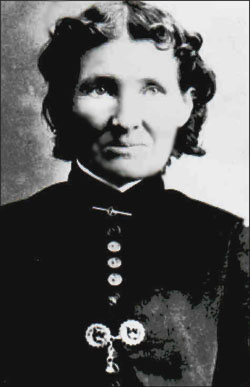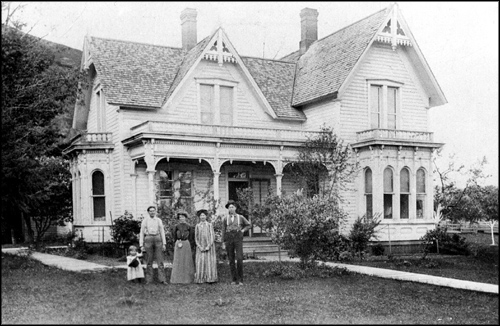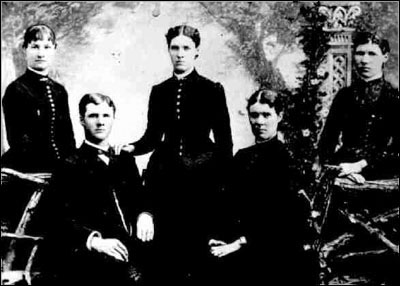Martha Dodson and Thomas May
of Columbia County, Washington

Martha Dodson May
Martha Dodson and Thomas Madison May were early pioneers in both Oregon and Washington Territories.
Martha was born November 11, 1841 in McDonald County, Missouri. When she was 11 years old, her family crossed the Oregon Trail to settle an Oregon Donation Land Claim in Douglas County. Martha claimed French ancestry, perhaps on her mother's side of the family, as the Dodsons were of English descent. When she was 19, Martha married Thomas Madison May, a 26-year-old carpenter and resident of Roseburg.
Thomas M. May was born February 24, 1834 in Meadville, Crawford County, Pennsylvania to Thomas C. May and Jane Moyers. His grandfather was John May who had immigrated from Ireland shortly before the Revolutionary War.
When he was ten years old, Thomas' parents moved to Illinois and settled on a farm in DeKalb County, sixty miles west of Chicago. They remained there for the rest of their lives and are buried in the Kingston Cemetery in DeKalb County. Thomas acquired a common school education there, and then served as an apprentice to a cabinetmaker.
After his apprenticeship ended, he headed for New York City where he boarded a ship for the gold fields of California. His trip may have been inspired by his cousin, John W. May, who lived in neighboring Boone County. A year earlier John had returned from a three-year adventure in California with a small fortune – $3,600 in gold nuggets.
Sailing to San Francisco
Thomas left New York harbor on September 5, 1855 and arrived in San Francisco on October 26, 1855. Had he taken a clipper ship around Cape Horn, his journey would have taken up to six months, so he must have traveled on one of the many steamers which chugged from New York to Aspinwall, a port on the Atlantic side of the Isthmus of Panama. The trip across the isthmus would have involved a 13-mile train ride into the jungle, followed by a three-day pack trip on mules to Panama City, on the Pacific Ocean. From there, he would have boarded another steamship that would have taken him and the other prospectors, likely packed shoulder to shoulder, to San Francisco. While fraught with many dangers and inconveniences, this route to the West must have been much easier than the six-month Oregon Trail trek Martha had endured in 1852.
Thomas lived in California for several years mining gold in Shasta County, on the California-Oregon border. Then in the spring of 1858 he headed north to Douglas County, Oregon where he met Martha. They were married in Roseburg on December 13, 1860.
The Mays spent the first decade of their marriage in Roseburg where Thomas worked as a carpenter, and Martha cared for the first of their nine children. In 1871 the family sold out and headed for Washington Territory. They homesteaded on Rock Creek in Whitman County in an area known as the Palouse – so named for the small band of Indians who were indigenous to the region.
Because of relatively low rainfall, the first settlers in the Palouse believed the land was suitable for little more than grazing. But in the mid-1870s, immigrants from eastern Europe, who were familiar with similar climatic conditions, began growing winter wheat – a crop planted in the fall and harvested the following summer. With winter wheat, the Palouse country had found its destiny and the settlers their prosperity.
Settling in Columia County
In the spring of 1876, the Mays sold out again and settled in Thorn Hollow, a valley about five miles northwest of the town of Dayton, in Columbia County. The family always referred to the home place as the "ranch." Thomas kept a number of horses and, according to his granddaughter Mattie, only drove and rode the very best.
The town of Dayton, which sits at the confluence of Patit Creek and the Touchet River, has a rich and interesting history. Lewis and Clark had been through in 1806, camping on the banks of Patit Creek on their return trip east. At that time, the current town site of Dayton served as a major camping ground for the regional Indian tribes which included the Nez Perce, Walla Walla, Yakama, and Umatilla. What is now Dayton's main street was the tribes' horse racing track. Even as late as 1859, there were 100 Indian families camped on the site.
Although Dayton had been platted in 1871, at the time of the May's arrival, it consisted of little more than a flouring mill, general store and post office. By the end of the decade, however, Dayton had seen considerable growth and came to be known as a "wild and wooley" place. It had a Weinhard brewery and 15 saloons for its 1,500 residents. Gambling was wide open, and Dayton entertained some of the best-known desperados of the West until law and order was established.

The May Home in Thorn Hollow
In 1878, a couple of years after their move to Columbia County, Thomas formed a partnership with Henry Gale, and they founded Dayton's first and only Republican newspaper, The Columbia Chronicle. Henry was the editor and Thomas was the business manager. An article on Thomas stated, "Mr. May is a staunch Republican and always has been, casting his first vote for Abraham Lincoln and for every Republican president since that date. He has never scratched a ticket, always taking it straight."
Sometime in the late 1800s, Martha and Thomas built a fine Victorian home at their ranch in Thorn Hollow. Between 1880 and 1910 many other prosperous settlers also built large homes in Dayton in the Queen Anne, Italianate, Gothic, and Craftsman styles. Today, 90 of these are on the National Register of Historic Places including the train depot and county courthouse, which are the oldest in the state. Sadly, all that remains of the May home is the fireplace and foundation.
The May Children
Both May sons were said to have gone to college, and it is likely that all the children completed 12 grades since Dayton boasted Washington Territory's first high school. After they were grown, most of the May children stayed in the Palouse.
Roxy May, the oldest, was born September 27, 1861 in Roseburg. On March 30, 1882, she married Henry J. Young and they settled on a large wheat farm in Pullman, Washington. They had five children - Glenn, Eva, Wade, Beade, and Thomas.
My great grandmother, Genette May, was born December 4, 1862 in Roseburg. She became a school teacher and on June 5, 1888 married my great grandfather, Arthur Thorpe, at her parent's home in Thorn Hollow. They had five children - Earl, Mattie, Arthur, Ray, and Mary.
Hugh Delos May was born July 14, 1864 in Roseburg. He and his younger brother Thomas Edwin May always went by their middle names – Delos and Edwin. When he was 20, Delos married Ava Elder whose family also had a place in Thorn Hollow. They lived for a time at his parent's ranch and then moved to a farm near Washtucna in Adams County. They had six children – Grace, Nina, Nita, Mayme, Delbert, and little Dale who died as a toddler at the home of his grandparents. Delos and Ava divorced in 1907, and he married Ruby Eleanor Rowley of Roseburg, Oregon. They moved to a farm in Walla Walla, Washington and had two daughters, Eleanor and Helen. Besides farming, Delos was also a federal employment agent for several years, was engaged in the real estate business, was president of the Walla Walla Dairymen's Association, and was a member of the farm loan board. He had lived in Walla Walla for 25 years when he died in 1935 at the age of 71.
Byra May was born April 23, 1866 in Roseburg and was 18 when she married Edwin J. Elder on September 24, 1884. Edwin was a photographer, and they made their home in Dayton. They had at least two children. One son, Wayne, was born in 1888, and Byra was just 35 when she died in 1901 after giving birth to their last child, also a boy. The names of their other children are not known.
Mary L. May was born in Roseburg on March 24, 1868. She graduated from Dayton High School and took up nursing, taking care of patients in their homes long before there was a hospital in the community. On July 30, 1893, she married Robert M. Hester and they had two children, Walton and Hester May Hester. In 1915 when Dayton opened Brining Hospital, Mary became its manager. A 1918 newspaper article written in honor of Mary's fiftieth birthday reads, "She ministers to all cases with a tenderness and patience that, combined with the skill obtained from her years of study and practice, bring about remarkable recoveries and win for her the lasting gratitude and friendship of her patients." When her daughter Hester died of a heart condition in 1928, Mary also raised her two grandsons, Maurice and Pat. By this time she and Robert had moved to Clarkston, Washington. She lived out the rest of her life in Clarkston, dying in 1946 at the age of 78. Her obituary paid tribute by saying, "She was a fortress of strength to her family and to her many friends in time of sickness or sorrow."
Mida F. May was born September 18, 1876 in Dayton, and died when she was just 19 months old on June 10, 1878.
Lena May was born in Dayton on April 14, 1879. She was 21 years old when she married Jasper William Harsch on May 27, 1900. In 1916 the couple moved to a large wheat farm outside Waitsburg in Walla County. Lena and Jasper had six children – Carl, Donovan, Jack, Myron, Martha, and another daughter. Lena had been chronically ill for many years when she died at the age of 59 from heart failure.
Thomas Edwin May was born July 30, 1881 in Dayton. He married Mary Schaeffer about 1903, and they took over the family wheat farm in Thorn Hollow. Mary died sometime before 1930, and Edwin moved to Dayton where he died on July 5, 1952. He is buried in the Dayton City Cemetery.
Martha May, the youngest child, was named for her mother and went by the nickname Mattie. She was born November 23, 1884 in Dayton. When she was 40, she married Wallace Mack Blowers of Walla Walla. They first lived in Hoquiam, Washington and later moved to Longview where he had a music store. They had no children but Mary Thorpe Newcomb went to live with her Aunt Mattie for some time after her mother Genette died in 1922. Mack died on September 16, 1949 in Longview.

The May's Five Oldest Children
Seated are Hugh Delos and Genette. Standing at the left is Mary
and we believe the other two are Roxy and Byra.
Newspaper articles on the Mays show a close-knit family with Thomas and Martha's large house serving as the hub of activity. Most of the May children were married in their parent's home, and many of the grandchildren were born there when the daughters came home for their confinements. One of these grandchildren was my grandmother Mattie Thorpe McCarter, born December 6, 1892.
Thomas and Martha were also visited by other relatives including Thomas' brother and sister from Illinois, and Martha's sister Lydia from Montana. They also made frequent trips to Roseburg, Oregon to visit Martha's family there.
Thomas was just 69 when he died on December 14, 1903. He had lived through Dayton's heyday and watched the population of Columbia County swell to more than 7,000 residents. He also lived to see California, Oregon, and Washington gain statehood. His obituary stated that Thomas was a successful businessman and left a valuable estate to his family.
Martha lived for another 17 years. She attended the Methodist Church and was a highly respected member of the community for more than 40 years. She was 79 when she died on May 26, 1920 at the home of her son Edwin.
Coincidentally, both she and Thomas died of kidney disease, perhaps having had scarlet fever at some time in their lives. They are buried in the Dayton Cemetery as are most of their children.
Special thanks go to my aunt, Irma McCarter Petrick, and Liz Carson of the Dayton Memorial Library for providing the notes and materials for this article. Also thanks go to Steve Jacobson, Coordinator of the Columbia County Gen Web Project, who spent a day searching Dayton and Thorn Hollow to locate what remained of the old May home.